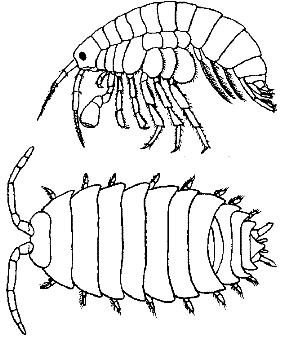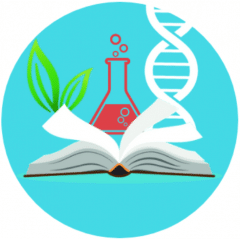| Isopods in Training |  |
Introduction:
Terrestrial isopods are land dwelling crustaceans, commonly known as sowbugs or pillbugs (or rollypollys). They are related to lobsters, crabs, and shrimp and terrestrial isopods breath with gills. While they look similar, sow bugs are different from pill bugs. Pill bugs will curl into a ball when threatened whereas sow bugs will attempt to flee.
Ethology is the study of animal behavior. Many behaviors involve movement of the animal within its environment. In this exercise, you will investigate some innate (instincts) behaviors of isopods. Orientation is a process by which animals position themselves with respect to spatial features of their environments. Taxis involves the turning of an animal’s body relative to a stimulus – either toward or away. Kinesis is a random turning or movement of an animal in relation to a stimulus.
Materials:
isopods, behavior chamber, paper towels, water
Procedure – Orientation of Isopods in Response to Moisture
- Cut paper towels to fit into the bottom of BOTH sides of your behavior chamber.
- Moisten one side with tap water while keeping the other side dry.
- Transfer 5 isopods to each side of the chamber (total of 10).
- Count and record the number of animals on each side of the chamber every 30 seconds for ten minutes.
- Record your data in the data table.
Data:
| Time | # in Wet | # in Dry |
| 0:00 | ||
| 0:30 | ||
| 1:00 | ||
| 1:30 | ||
| 2:00 | ||
| 2:30 | ||
| 3:00 | ||
| 3:30 | ||
| 4:00 | ||
| 4:30 | ||
| 5:00 | ||
| 5:30 | ||
| 6:00 | ||
| 6:30 | ||
| 7:00 | ||
| 7:30 | ||
| 8:00 | ||
| 8:30 | ||
| 9:00 | ||
| 9:30 | ||
| 10:00 |
Analysis:
1. Based on your observations, do isopods prefer a moist or dry environment.
2. Would this movement be taxis or kinesis? Explain your answer.
3. Suggest a reason why this behavior might be advantageous to an isopod
4. Select one of the following factors and design an experiment to test for your hypothesis.
| Factor | Materials (suggested) |
| Temperature | cold pack, warm pack |
| Light | lamps, flashlights, dark construction paper, aluminum foil |
| pH | low pH (HCl), high pH (NaOH) |
| Substrate (surface) | soil, sand, sandpaper, bark, paper, cedar chips, gravel |
| Odor | ammonia |
| Food | apple, potato, fish food, lunchmeat |
| Other Organisms | mealworms, crickets, earthworms |
